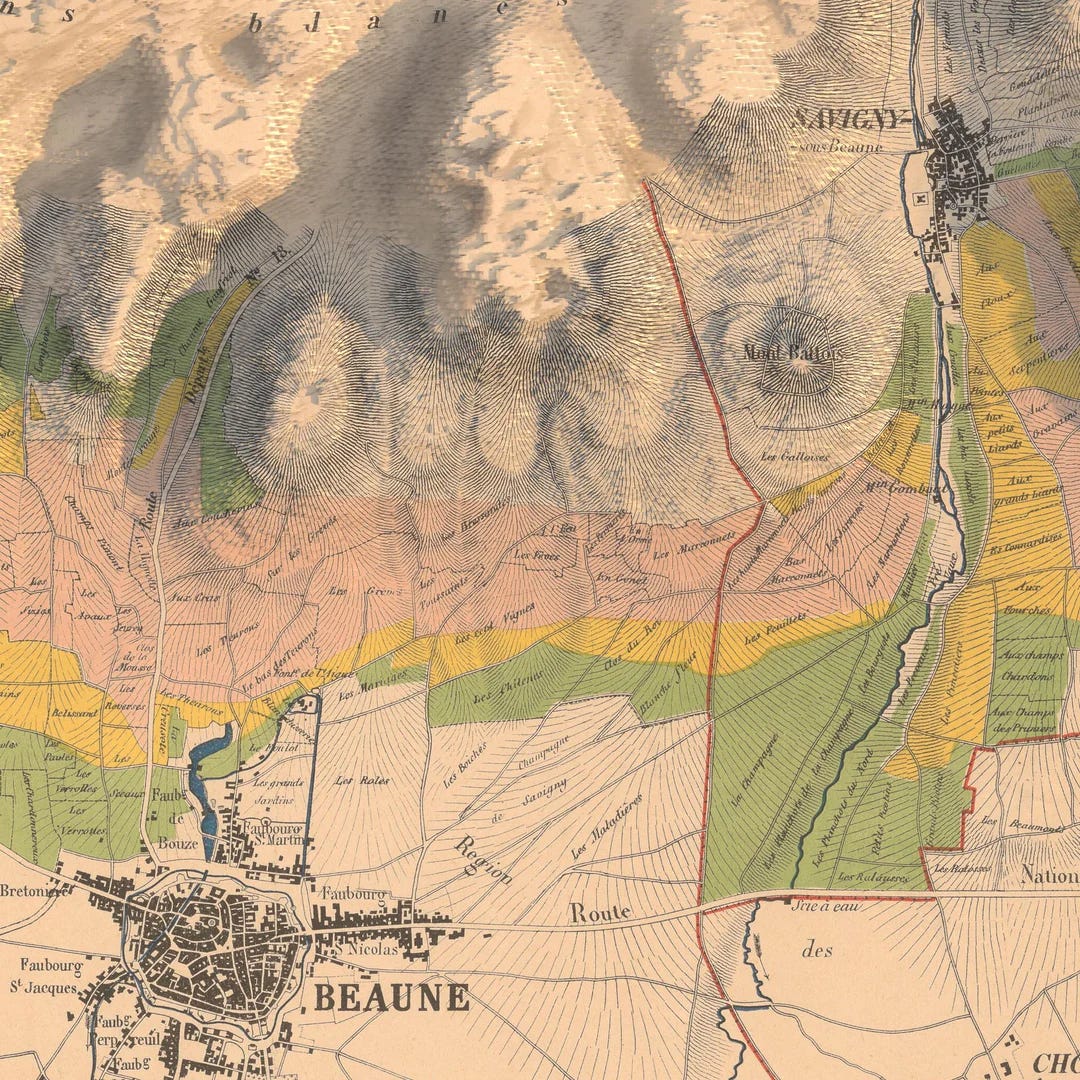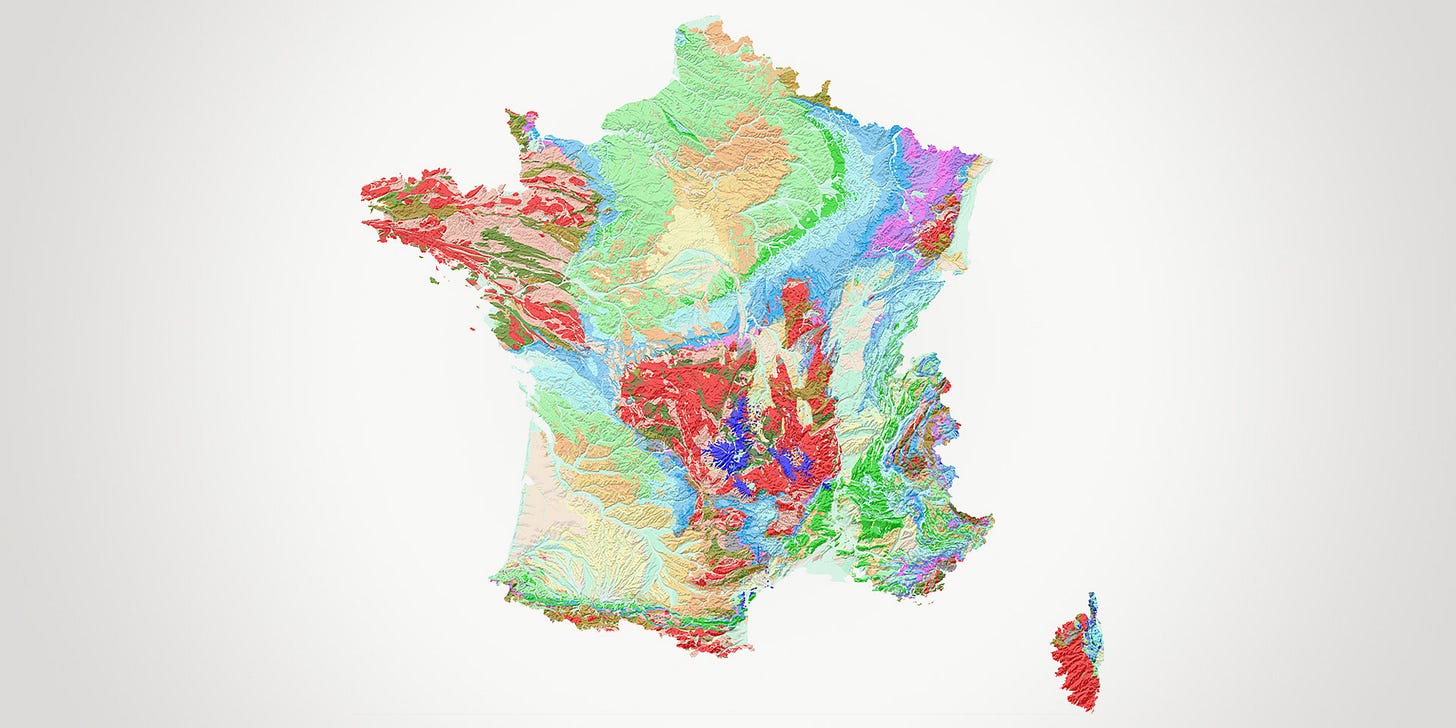We walk from the train station to Rue des Tanneries on the outskirts of the ramparts surrounding the village of Beaune. Both my partner and I spent time here in our 20’s, working and living for an international bike tour company that shaped a lot of our lives, a certain joie de vivre taught in a cult like joy of a workplace that took people on biking and walking vacations around the world.
It has been 15 years since either of us have been back, we have children, we are older, but the memory of this place stuck out and lodged itself deep in our brains to return. It is all so familiar and wonderful, France in Spring. Bright daytime light, the kind that artists know how to discuss and enjoy, clear, crisp light and air and water and soil that make grapes thrive; it is a region known for its wine. There are winds that come from the west, north, east, and south, at various times of the year; the blue sky here feels like summer in Mongolia, on the steppes.
We are staying at a friend's apartment which looks out to a small river housed in an in-ground aqueduct. The river supplies the old city with a moat and on the west side (we are on the east, the flow out), on the west side the river flows into the village and is split. It was once called the Belena river but is now known as the Bouzaize. Part flows underground in long hidden waterways covered by roads, houses, and churches; part flows into a moat and circumnavigates the walled village coming out on the other side, past our apt, where the tanneries used to be curing their leathers. Long ago the river was worshiped and that is how the village both grew its name and its location. This same water rises from the earth close by in a spring, and eventually flows out near Marseille into the mediterranean sea, five hundred kilometers away.
The name "Beaune" derives from the Latinised Gaulish word "Belena", which was the name of a spring around which the settlement was established. That name in turn is derived from "Belen" or "Belenos", a pagan god of fast-flowing water, of fire and light, worshiped primarily in Gaul and Britain and later folded into Apollo. This god was associated with the sun, healing, and prophecy. People would come here to worship this god, and gather near the water, it became a destination, a place, and eventually a village.
The Celtic festival Beltaine (a worship of Belenos) marks the beginning of the summer season and takes place on the full moon of May. Beltaine is between the end of winter and the summer solstice. It is the same story as May Day and maypole dancing, it marks a threshold in the year, when the light season is well underway. It was, in ancient times, the opening of daytime activities: resumption of hunting, war, raids, conquests, beginning of agrarian and field work for farmers and breeders. In this sense, it is the total antithesis of the festival of Samhain (the origin festival of Halloween). It is the period for rites of passage between the cold and hot periods, between darkness and light, between psychic death, or symbolic torpor, and spiritual rebirth.
The source of the river is west of the city, from the foot of the vines, and is the terminus of a public park. This park we visit each day while here as it is perfectly proportioned, with a variety of trees, clear water out of the limestone plateau of Morvan to the west, filtered and rising out of a crack in the earth. Some remarkable trees can be seen in this Park, they stand out:
a Lebanese cedar (Cedrus libanii) near the main entrance,
Bald Cypresses (Taxodium distichum) at the ends of the islands,
a Silver Linden (Tilia argentea) approaching the playgrounds,
two giant Sequoia trees (Sequoiadendron giganteum) near the aviary,
two entwined beeches , one weeping (Fagus sylvatica 'Pendula') and the other common(Fagus sylvatica 'Asplenifolia').
I go to the Beaune tourism office to ask about the name of the river, Bouzaize, and the spring. The woman at the front desk giggles when I ask about Bouzaize and she calls back to her colleague Emilie in the back to come out and explain.
“I am so sorry, the name of the river…. it is… it means cow poop.”
I am sure I heard it wrong so ask, “Sorry, what was that again?”
“Cow Poop, it isn’t very nice of a name but that is what it means, originally it was called the Belenos river, after a god, but then there were lots of cows near it and, well, et voila!”
The staff tell me there is a Celtic temple buried deep under the Collégiale Notre-Dame, the church in the center of the village, one of the last great Romanesque churches in Burgundy. You see this all around the world, a new religion moves in and appropriates the old landscapes into it’s own mythologies. Here Christian from Pagan and Celt. The river flows through the caves under the church as well. There is a hidden underground Beaune, Borges like, that mirrors the village, a flip world, an underworld, kilometers of caves. When Christianity came from the east they built on top of the worship site of Belena, the goddess of Spring. The Church on top of the temple began in the mid-12th century and was completed at the beginning of the following century. The staff also tell me there are two springs that feed the river, and that I should walk past the park, down a dirt track beyond a field to find the other spring, tucked away in a corner of a few properties on the outskirts of town. They make a hand drawn map to show me an approximation. My son and I decide to go and find it one day, we start from the park and the big spring we have enjoyed. There is a small space in the large wall surrounding the park that we find woven behind shrubs and trees, a door in the stone wall, a clos, and we exit into the vineyards. When you leave the village and enter the vineyards it is like the demarcation of land to ocean, or oasis to desert, it is a clear delineation and it is stark. There is little tree cover in the vines, a sea of green and gold. It is called the Côte-d'Or, the Slope of Gold. We both see the offshoot creek that helps feed the pond and roman looking baths off the side of a side road. We walk past there trying to remember the map, up a dirt track looking ahead where we can see trees and growth, a place a spring might be. We turn a corner and there flowing out of the limestone is cold water rising.
We are elated and excited, like we have found something new, fully knowing this is a worshiped site known for thousands of years. There is mojo here, spirit, you can feel something that makes it no surprise the Pagans worshiped places like this as special geographies that were closer to some spiritual plain. We both reach down to feel the water and it is cold like ice and we brush it on our necks to cool down much like a baptism. My son was gobsmacked to the point his jaw dropped and out rolled his chewing gum into the cool waters.
From these two springs come life, out of the earth, rising, housing plants and algae, insects and birds, shrubs and trees, vines and people, and in this way the village was born. Years ago humans would come here because of the water, just like the fowl and flora. They would come and feel the nourishment, the coolness, and the life. Markets sprang up from the pilgrims and the crossroads and then they were, slowly, built upon, to one day shape what is here now, a fortified city now known for some of the best wine in the world. The market still comes, every Saturday at the footsteps of the church, and is one of the best in the region. A true crossroads of places as geographically you can walk north east to avoid the alps and make it all the way to the Gobi, or you can walk south following the Bouzaise to the Saone which flows to the Rhone to the Sea, a slow, downhill way, avoiding the alps and the central massif mountains. North-north-west 60 km and you meander to the source of the Seine and onwards to Paris, to Monet's Giverny and then to the English channel. The rivers and waterways producing collections of life and cities, showing that rivers aren’t just gravity pulling on water, but some sort of organizing power, a oneness, flowing life.
The climate, the water, the wind, the space and time all shape how it is this place came to be. It sounds obvious, but there are so many disconnected places these days it seems rare to understand the direct connections of landscape and place and peopled cities. Much like the food we eat seems so far from the source, that many of us do not understand where the bacon or the steak came from. We no longer connect that the village came from the river. There are traces of it if you know where to look, the names of streets and the language left behind, the tidemarks of landscape, the terroir.
I have found that when I reach a place that I like, a landscape where I shine in, it is far more often than not that the ground underneath me is limestone and I don’t know what this means or why. Perhaps it is the porous nature of limestone regions, that there are hidden landscapes and waterways in the rock, that the geography is written on by the weather, as limestone is shape-able by water and time. Or it could be that limestone is created by the detritus of ocean life, shells and bones, compacted with time, Calcium Carbonate, which in turn releases Carbon Dioxide, the half of photosynthesis that dances with photons and light to feed all life. Here, the river and the stone both composes and are composed from living things; there must be something left in the land that vibrates all of this out into the ether.









I am new to your substack and it feels like stumbling upon a treasure chest. Thank you for your delicious words.
Lovely. Sources, springs, water coming up out of the ground...always powerful and moving. You know Robert MacFarlane's Underland book, of course. Did you know he's going to be speaking at MAssey College this Thursday morning? 8.30 breakfast talk, about his new book, ...Rivers...something